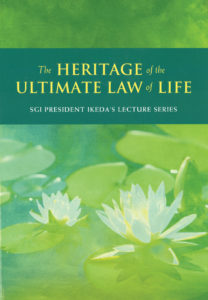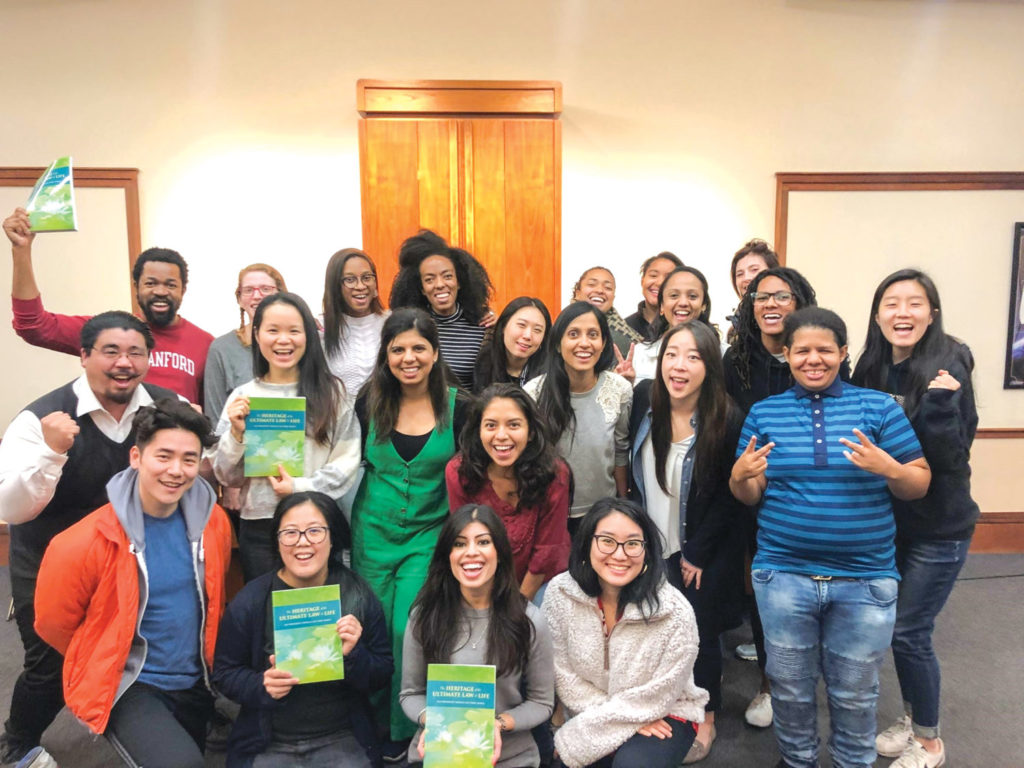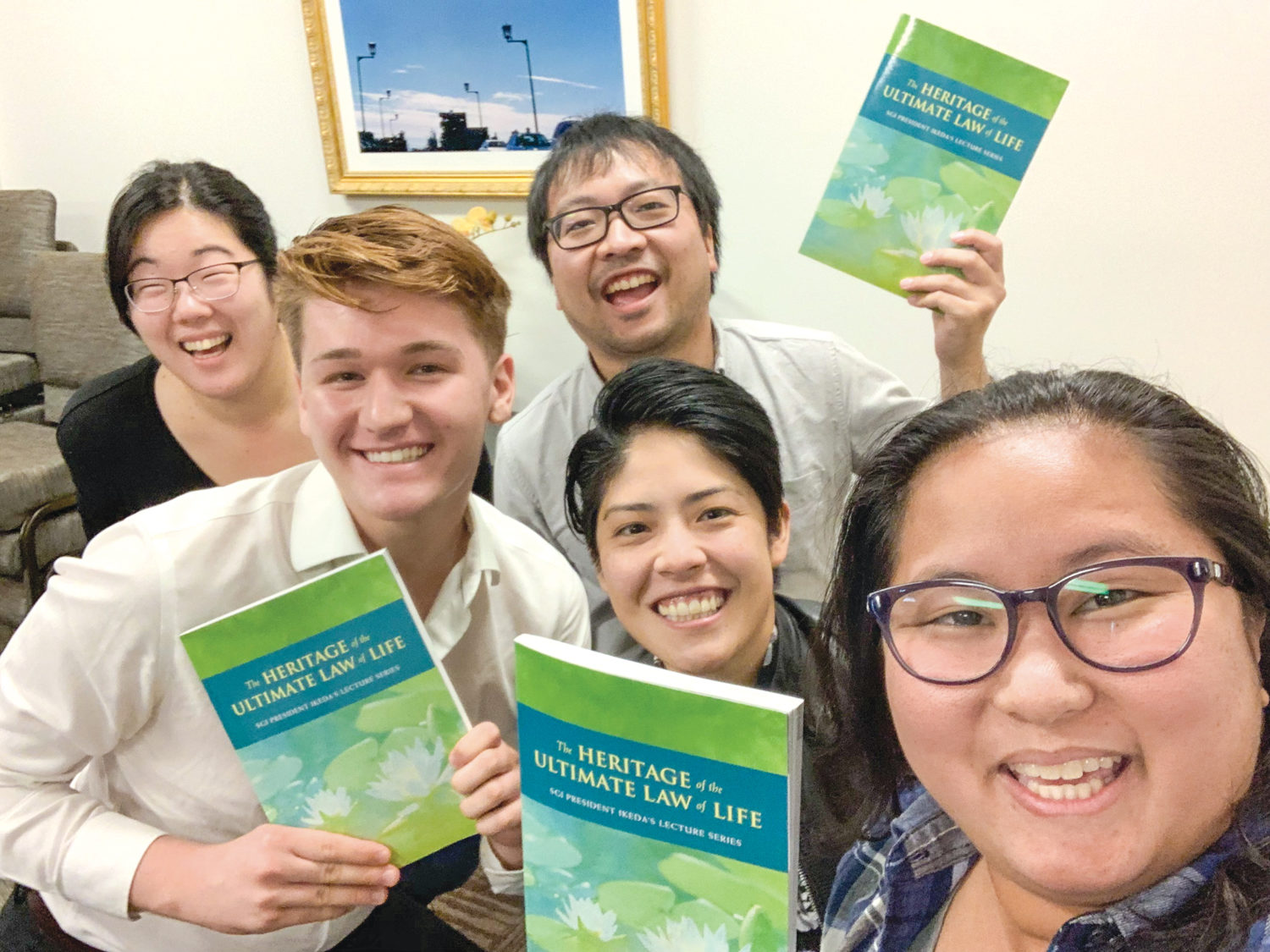The Ikeda Wisdom Academy is an SGI-USA youth division movement to engage youth leaders in advanced study. This month, academy members will study chapter 5 of The Heritage of the Ultimate Law of Life: SGI President Ikeda’s Lecture Series.
While the Ikeda Wisdom Academy is a youth leaders study program, all SGI-USA members are invited to utilize this section of Living Buddhism as a guide for their personal study of “The Heritage of the Ultimate Law of Life.”
– – – – – – – – – – – – – – – – – – – – – – – – – – – –
Syllabus – December 2019
The Heritage of the Ultimate Law of Life: SGI President Ikeda’s Lecture Series, Chapter 6
– – – – – – – – – – – – – – – – – – – – – – – – – – – –

Chapter 6
The Present Holds the Key to Eternal Victory—The Spirit That Now Is the Last Moment of One’s Life Assures a Correct and Steadfast Mind at the Moment of Death

Nichiren Daishonin emphasizes that the most essential point in embracing Myoho-renge-kyo is to practice with the spirit of faith that “now is the last moment of one’s life.” By practicing with this spirit toward fulfilling our vow in this lifetime, we are able to create the utmost value at each moment.
For one who summons up one’s faith and chants Nam-myoho-renge-kyo with the profound insight that now is the last moment of one’s life, the sutra proclaims: “When the lives of these persons come to an end, they will be received into the hands of a thousand Buddhas, who will free them from all fear and keep them from falling into the evil paths of existence” [The Lotus Sutra and Its Opening and Closing Sutras, p. 363]. How can we possibly hold back our tears at the inexpressible joy of knowing that not just one or two, not just one hundred or two hundred, but as many as a thousand Buddhas will come to greet us with open arms!
Concerning one who disbelieves the Lotus Sutra, because the sutra states, “When his life comes to an end he will enter the Avichi hell” [LSOC, 110], the wardens of hell will surely come for one and take one away by the hands. How pitiful! The ten kings of the world of the dead will then pass judgment, and the heavenly messengers who have been with one since birth will berate one for one’s evil deeds.
Think of those thousand Buddhas extending their hands to all of Nichiren’s disciples and lay supporters who chant Nam-myoho-renge-kyo as melons or moonflowers extending their slender vines. (The Writings of Nichiren Daishonin, vol. 1, pp. 216–17)
Birth and Death in the Realm of Buddhahood
Citing the Lotus Sutra, Nichiren Daishonin asserts that “one who summons up one’s faith and chants Nam-myoho-renge-kyo with the profound insight that now is the last moment of one’s life” (WND-1, 216) will savor immense inner peace and tranquillity at death, protected by a thousand Buddhas. This is the meaning of a correct and steadfast mind at the moment of death. In other words, those who strive in faith with the spirit that now is one’s last moment are on the path of attaining Buddhahood in this lifetime . . .
To believe and understand that the Buddha, the Law and we ourselves “are in no way different or separate from one another” (WND-1, 216) is to be convinced that our own lives, as entities of Myoho-renge-kyo, are one with the Buddha and undergo the same birth and death as the Buddha—that is, experience birth and death in the realm of Buddhahood. It means living with bright hope and optimism while making the revelation of the inherent Buddhahood in this lifetime our ultimate goal. Accordingly, those committed to practicing as Nichiren teaches will naturally come to have the spirit that now is one’s last moment.
The moment of death represents a final accounting of this existence—the outcome of which is strictly decided by how we have lived. Will we meet our last moment with immense satisfaction, filled with deep appreciation and free of all regret? Or will we meet the final curtain of this lifetime overwhelmed by regret and self-reproach? A person’s whole life is condensed into that last moment, without any possibility of deception or concealment.
That’s why it is crucial to live each moment to the fullest, especially if we want to be able to say: “If I were to die right now, I would have no regret or dissatisfaction. My heart would be serene and tranquil.” To strive in faith with the spirit that now is our last moment is to earnestly give our all to the present, determined to have no regrets even if this moment should be our very last. (The Heritage of the Ultimate Law of Life: SGI President Ikeda’s Lecture Series, p. 52)

NY Ikeda Wisdom Academy. Photo by Nate Zavin.
A Brilliant Departure Toward the Next Existence
Let’s clarify the meaning and relationship between the spirit that now is one’s last moment and a correct and steadfast mind at the moment of death.
First, the spirit that now is one’s last moment means living each moment and each day fully and without regret, deeply aware of the significance of our last moment as a final accounting of this life. In this sense, the wisdom and insight into life possessed by those who strive in faith with this spirit gives them confidence and determination, and further fuels their vibrant hope and tireless actions.
A correct and steadfast mind at the moment of death, meanwhile, is derived as a natural course of striving earnestly in faith day after day, month after month, year after year, with the spirit that now is one’s last moment. By doing so, we can forge and polish our lives and elevate our state of mind. We can also feel total confidence and satisfaction about how we have lived, so that when the moment of death comes, we can “make our way to Eagle Peak,” as Nichiren Daishonin says, peacefully and without regret, having chanted Nam-myoho-renge-kyo earnestly throughout life. This magnificent state of being is what it means to have a correct and steadfast mind at the moment of death.
Very simply, our continual efforts in faith based on the insight that now is the last moment of life will ensure that we have a correct and steadfast mind at the moment of death. And having a correct and steadfast mind at the moment of death makes it possible for us to depart with complete fulfillment and satisfaction toward the next life. (Lecture Series, 53–54)
Those Who Live With the Insight That Now Is One’s Last Moment Experience Joy in Both Life and Death
Regarding birth and death in the Ten Worlds, we can experience birth and death in any of the worlds from hell through Buddhahood. Of course, as entities of the mutual possession of the Ten Worlds, it is possible for us to change our state of life during the course of our present lifetime. But it is inevitable that the predominant state of life of the Ten Worlds we have established as the outcome of this existence will carry over into our next existence. That’s why it’s vital that we fundamentally transform our state of life while we’re still alive.
Deepening our perspective on life and death leads to deepening our own lives. Josei Toda, the second Soka Gakkai President, often said, “In truth, we practice faith for the time of our death.” The essence of any religion is found in the way that it views life and death. (Lecture Series, 55)
The Importance of Accumulating “Treasures of the Heart”
A life that has been forged in the struggle for kosen-rufu is indestructible. Based on the Buddhist principle of the oneness of life and death, those who have accumulated “the treasures of the heart” (“The Three Kinds of Treasure,” WND-1, 851) have already cultivated the state of life with which to attain Buddhahood. Through the good fortune and benefit they have gained as a result of persevering in their mission for kosen-rufu, they experience a magnificent life and death, setting them on a course where they can forever undergo birth and death in the realm of Buddhahood. (Lecture Series, 56)
“Profound Insight” Means a Deep Inner Awareness
Returning to the start of the quotation we are studying this time, we find the passage “with the profound insight that now is the last moment of one’s life” (WND-1, 216). Here, “profound insight” means belief and understanding, or resolute faith. It means realizing deep in our hearts that our own birth and death are inherently birth and death in the realm of Buddhahood. One could say that all who work tirelessly for kosen-rufu in the SGI already possess this realization in the depths of their lives.
Faith that grows stronger day by day and month after month corresponds to faith based on the spirit that now is the last moment of one’s life.
Precisely because life is eternal, we must exert ourselves wholeheartedly in the present. Taking action based on this deep awareness is what it means to possess “the profound insight that now is the last moment of one’s life.” (Lecture Series, 56)
Overcoming Obstacles and Devilish Functions
Those who habitually avoid confronting the three obstacles and four devils in their daily lives will be utterly unable to defeat the hindrance of death—the most daunting of all obstacles. The essence of practicing with the spirit that now is one’s last moment is to not be beguiled or frightened by the workings of devilish functions. For that reason, we must summon forth the faith, wisdom, courage and life force to confront them. One who has battled and completely triumphed over all devilish functions is a Buddha. Put another way, a Buddha is one who has conquered the most formidable of the four devils—the hindrance of the devil king and the hindrance of death—and has attained a “state of deathlessness” [based on enlightenment to the eternity of life].
At the time of the Tatsunokuchi Persecution, Shijo Kingo was ready to protect Nichiren Daishonin to the very end, even at the risk of his own life; and yet, as the execution appeared imminent, he cried out tearfully, “These are your last moments” (“The Actions of the Votary of the Lotus Sutra,” WND-1, 767). Though probably out of concern for his mentor, Shijo Kingo may have given way to fear at seeing this remorseless attack by devilish functions. Nichiren instantly responded with a powerful lion’s roar: “You don’t understand! What greater joy could there be?” (WND-1, 767). These words, epitomizing a correct and steadfast mind in the face of imminent death, sum up the supreme essence of the life and death of a Buddha. Nichiren fought head-on against the insidious devilish forces that assailed him, triumphing over the hindrance of death and the hindrance of the devil king. The world of Buddhahood is established in the lives of those who fight with this spirit.
Nichiren urges his disciples struggling amid great persecution: “Strengthen your faith day by day and month after month. Should you slacken in your resolve even a bit, devils will take advantage” (“On Persecutions Befalling the Sage,” WND-1, 997). Faith that grows stronger day by day and month after month corresponds to faith based on the spirit that now is the last moment of one’s life. Faith of this sort enables us to ward off and defeat devilish functions. The opposite of this is “slackening resolve” and “fear of devilish functions.”
As indicated by the passage “they will be received into the hands of a thousand Buddhas” (LSOC, 363), those who have a correct and steadfast mind at the moment of death will be instantly greeted by innumerable Buddhas, bodhisattvas and heavenly deities—the protective functions of the universe (see WND-1, 216). It is vital that we always remember, though, that this is brought about only as a result of our own efforts in faith to combat evil and realize good. The powerful life force of Buddhahood wells forth in the lives of those who possess such a fighting spirit. (Lecture Series, 56–57)
You are reading {{ meterCount }} of {{ meterMax }} free premium articles

